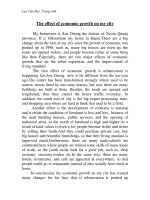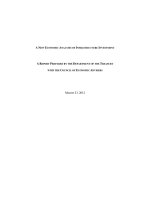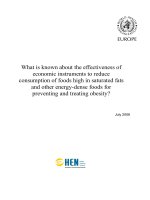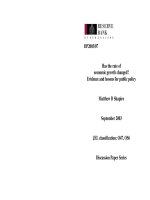The foundations of economic statistics
Bạn đang xem bản rút gọn của tài liệu. Xem và tải ngay bản đầy đủ của tài liệu tại đây (525.18 KB, 51 trang )
Macroeconomics for Public Policy
The Foundations of Economic Statistics
Tran Lam Anh Duong
5-6 February 2018
1
The Gross Product
• Definition of Gross Product :
The total value of all final goods and services produced within a country,
that is, the production of the whole country.
• Definition of GDP (Gross Domestic Product)
GDP is a statistic index used to measure gross product from available
data.
2
GDP
• We assume that there is one type of good in the economy.
Total amount of newly produced goods which is traded in the country’s
market during a given period.
We only take into account newly produced goods.
Targeting goods are trading goods in the market.
3
GDP
• There are several types of goods and services
How to add up different goods and services?
Example 1: Country X produced 100 hamburgers, 100-liter Oolong Tea, and
100-kilogram potato in one year.
⇒ The measure of unit is different.
⇒ It is impossible to do the addition.
Example 2: Country A produced 1-ton scrap iron and 100-ton gold bar last
year. Country B produced 100-ton scrap iron and 1-ton gold bar last year.
⇒ The sum of production is 101 tons for both countries.
⇒ However, the values of scrap iron and gold bar are different.
4
GDP
• Let’s refine the definition of GDP.
GDP is the sum of market value of the newly produced goods and
services in the economy during a given period.
5
Nominal GDP
• Nominal:The meaning of “Evaluation based on the unit of currency”
• 𝑁𝑁 types of goods
𝑌𝑌𝑌𝑌𝑌𝑌𝑌𝑌 𝑡𝑡 ′ 𝑠𝑠 𝑛𝑛𝑛𝑛𝑛𝑛𝑛𝑛𝑛𝑛𝑛𝑛𝑛𝑛 𝐺𝐺𝐺𝐺𝐺𝐺 = 𝑃𝑃1𝑡𝑡 𝑄𝑄1𝑡𝑡 + 𝑃𝑃2𝑡𝑡 𝑄𝑄2𝑡𝑡 + ⋯ + 𝑃𝑃𝑁𝑁𝑡𝑡 𝑄𝑄𝑁𝑁𝑡𝑡
𝑃𝑃𝑖𝑖𝑡𝑡 : 𝑡𝑡ℎ𝑒𝑒 𝑝𝑝𝑝𝑝𝑖𝑖𝑖𝑖𝑖𝑖 𝑜𝑜𝑜𝑜 𝑔𝑔𝑔𝑔𝑔𝑔𝑔𝑔 𝑖𝑖 𝑖𝑖𝑖𝑖 𝑦𝑦𝑦𝑦𝑦𝑦𝑦𝑦 𝑡𝑡 𝑖𝑖 = 1,2, ⋯ , 𝑁𝑁
𝑄𝑄𝑖𝑖𝑡𝑡 : 𝑡𝑡𝑡𝑡𝑡 𝑝𝑝𝑝𝑝𝑝𝑝𝑝𝑝𝑝𝑝𝑝𝑝𝑝𝑝𝑝𝑝𝑝𝑝𝑝𝑝 𝑜𝑜𝑜𝑜 𝑔𝑔𝑔𝑔𝑔𝑔𝑔𝑔 𝑖𝑖 𝑖𝑖𝑖𝑖 𝑦𝑦𝑦𝑦𝑦𝑦𝑦𝑦 𝑡𝑡
6
Nominal GDP
• The set of example 1:
Hamburger
Price (𝑷𝑷)
200 yen per one unit
Production (𝑸𝑸)
100 units
Oolong Tea
300 yen per liter
100 liters
Potato
400 yen per kilogram
100 kilograms
⇒ The nominal GDP of country X is
200 × 100 + 300 × 100 + 400 × 100 = 90,000 𝑦𝑦𝑦𝑦𝑦𝑦
7
Nominal GDP
• The set of example 2:
Price (𝑷𝑷)
⇒
Scrap iron
1 yen per ton
Gold bar
100 million yen per ton
A’s production (𝑸𝑸𝑨𝑨 )
B’s production (𝑸𝑸𝑩𝑩 )
100 tons
1 ton
1 ton
100 tons
Country A’s nominal GDP=10 billion and 1 yen
Country B’s nominal GDP=0.1 billion and 100 yen
⇒ Country A produced many goods with high market values, thus the
nominal GDP is high.
8
Nominal GDP
• Problem point: take example 1
Case 1: the price from 𝒕𝒕 to 𝒕𝒕 + 𝟏𝟏 is unchanged Case 2: the price from 𝒕𝒕 to 𝒕𝒕 + 𝟏𝟏 increases
by twice and the production is unchanged.
and the production increases by twice.
Price
Production Production
of year 𝒕𝒕
of year 𝒕𝒕 + 𝟏𝟏
Hamburger
200 yen
100
200
Hamburger
Oolong Tea
300 yen
100l
200l
Potato
400 yen
100kg
200kg
⇒ Nominal GDP of 𝒕𝒕 + 𝟏𝟏:
200 × 200 + 300 × 200 + 400 × 200
= 180,000 𝑦𝑦𝑦𝑦𝑦𝑦
Price of
year 𝒕𝒕
Price of
Production
year 𝒕𝒕 + 𝟏𝟏
200 yen 400 yen
100
Oolong Tea
300 yen 600 yen
100l
Potato
400 yen 800 yen
100kg
⇒ Nominal GDP of 𝒕𝒕 + 𝟏𝟏:
400 × 100 + 600 × 100 + 800 × 100
= 180,000 𝑦𝑦𝑦𝑦𝑦𝑦
⇒Nominal GDP is a measurement that reflects the change of the price, but doesn’t
reflect the production.
9
Real GDP
• Real: The meaning of “Evaluation based on the unit of goods”
• Base year: We can freely choose a base year, but usually that year is
convenient to be "a base".
• The unit price of goods and services used to calculate the real GDP in year 𝒕𝒕
is not the price in year 𝒕𝒕 , but the price of base year.
Real GDP in year 𝒕𝒕 = 𝑃𝑃1base 𝑄𝑄1𝑡𝑡 + 𝑃𝑃2base 𝑄𝑄2𝑡𝑡 + ⋯ + 𝑃𝑃𝑁𝑁base 𝑄𝑄𝑁𝑁𝑁𝑁
The price of 𝑖𝑖-th good in the base year: 𝑃𝑃𝑖𝑖base
Remark: To calculate real indicators in other years, we use the same unit
price of the base year
10
Real GDP
• Case of example 1: From year 𝒕𝒕 to year 𝒕𝒕 + 𝟏𝟏, the productions of all goods and
services are increased by twice ⇒ Real GDP will be increased by twice.
• Case of example 2: From year 𝒕𝒕 to year 𝒕𝒕+𝟏𝟏, the productions of all goods and
services are unchanged, and the prices of those are increased by twice. ⇒
What will the real GDP be?
Real GDP is a measurement that reflects the change of the production,
but doesn’t reflect the price.
※ In the future, “GDP” means real GDP.
11
The treatment of intermediate goods
• Intermediate good: A good or service used in production of another
good before the final stage of production.
• Final good: A good or service which is sold directly to consumers and
enterprises after the final stage of production
⇒ The value of intermediate goods is included as a part of the market
price of the final goods that they are constituted.
⇒ A problem: adding the intermediate goods to the final goods would
be double counting
12
The treatment of intermediate goods
• Value-add: A value addition to the good at one stage of its production.
• Example:
Value of production
Value added
Farmer A
Wheat flour 50 yen
50 yen
Farmer B
Beef 80 yen
80 yen
Farmer C
Vegetable 20 yen
20 yen
Hamburger seller
Hamburger 200 yen
200-50-80-20=50 yen
13
The treatment of intermediate goods
• Refine the definition of GDP:
GDP is the sum of value added of newly produced goods and services in the
economy during a given period.
• Take the example of hamburger, the sum of value added is 50+80+20+50=200
(yen)
⇒The sum of value added is consistent with the value of final goods.
• Next we can also define GDP as the following:
GDP is the sum of the value of final goods and services in the economy during a
given period.
14
Equivalence of three approaches
• Three approaches: product approach, income approach, and expenditure
approach
• The index from income approach: Gross income
Gross income is the income from the production of goods and services in the
economy during a given period.
• The index from expenditure approach: Gross expenditure
Gross expenditure is the expenditure on the goods and services produced in
the economy during a given period.
15
Equivalence of three approaches
• The example of the economy with one transition: a small country in a day
Farmer
200 yen of banana
Student
⇒ Gross product= Gross income= Gross expenditure=200 yen
• Principles of Equivalence of Three Approaches:Gross product, gross income, and
gross expenditure are always identical.
• Treatment of inventory (unsold items): Aren’t product, income and expenditure
identical?
⇒ Regard it as “I sold to myself”
⇒ Confirmation of principles of equivalence of three approaches
16
GDP Statistics
• The following principles are established to get the GDP statistics:
We just take into account the produced goods and services which are traded at the
market when calculating the gross product.
• What about housework and babysitting?
⇒ Housework and babysitting are not included.
• How about imputed rent of owned-house ?
⇒ It is not traded in the market, thus it is not included in GDP?? → Exception
⇒ The method to calculate GDP: “I sold to myself”(refer to rental rate of
neighborhood)
17
Vietnamese GDP Statistics
• Data Source:
Website of General Statistics Office of Vietnam
World Development Indicators
Penn World Table
• When we look at the real Vietnamese GDP,
Is it nominal or real GDP?
If it is real GDP, what is the base year?
The common mistake: compare GDP statistics or use time series data in
terms of different base year
18
An example of what leads to the common mistake
• Japanese GDP Statistics:
The change of Japanese real GDP
Trillion yen
600
500
400
300
200
100
2012
2009
2006
2003
2000
1997
1994
1991
1988
1990
based
1990年基準
1985
1982
1979
1976
1973
1970
1967
1964
1961
1958
1955
0
2005
based
2005年基準
Source: Japanese Cabinet Office Economic and Social Research Institute-GDP Statistics
19
Principles of equivalence of three approaches
• Review of principles of equivalence of three approaches
• There are three approaches to classify GDP.
Gross production
Gross income
Gross expenditure
20
Macroeconomics from product approach
• Review of Gross Domestic Product – GDP
• Components of GDP in terms of purposes:
Investment goods: Goods used for production.
Intermediate goods: Goods regarded as materials which are used to produce
other goods.
Consumer goods: Goods purchased by households, final consumption.
• Depreciation of fixed capital: a part of used goods that becomes
unusable or destroyed.
• Net Domestic Product – NDP: GDP minus the depreciation of fixed
capital.
21
Macroeconomics from expenditure approach
• Gross Domestic Expenditure - GDE
Agents in the economy can be divided into four groups: households, firms,
government, and foreign.
GDE can be divided into four categories: Consumption(C), Investment(I),
Government Purchases(G), Net Exports (NX=Exports―Imports)
GDE=Consumption+Investment+Government Purchases+Net Exports
(𝐺𝐺𝐷𝐷𝐸𝐸 = 𝐶𝐶 + 𝐼𝐼 + 𝐺𝐺 + 𝑁𝑁𝑁𝑁)
※ There are nominal and real items in each one.
22
Consumption
• Definition: Goods and services bought by households
• Components: 4 categories
① Nondurable Goods
② Semi-durable Goods
③ Durable Goods
④ Services
23
Investment
• Definition: Goods are bought not only for present use, but also for
future use.
※ Remark: It only refers to private investment, not government
investment.
• It is easy to misunderstand the word “Investment”⇒ Attention
Example 1: Firm A thought that the stock of firm B would rise soon, and
bought 1 billion yen of firm B's stock from firm C.
Example 2: Agent E bought an ancient building for 100 million USD, aiming for
an increasing in value.
24
Investment
• Components: 3 categories
① Equipment Investment: the purchase of production equipment by firms Fixed
Investment
② Housing Investment: the purchase of housing by households
③ Private Inventory Investment: the increase and decrease of firms’
inventories of goods
• Why is inventory not expenditure but investment?
Example: There are farmers and college students in one country.
1, May: Farmers produce one banana worth 200 yen and don’t sell to students, so it is
stored in warehouse.
2, May: There is no production by farmers. Students come and buy one banana.
⇒ What are gross product and gross expenditure during these two days?
25









